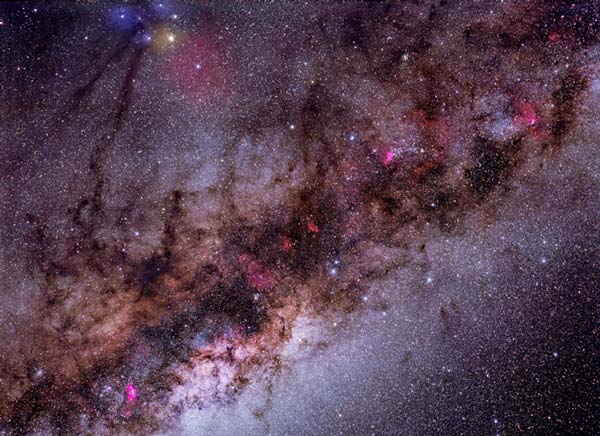
|
Credit & Copyright: John P. Gleason,
Celestial Images
Explanation:
The disk of our
Milky Way Galaxy is home to hot nebulae,
cold dust, and billions of stars.
The red nebulae visible in the above contrast-enhanced picture are primarily
emission nebulae, glowing clouds of
hydrogen gas heated by nearby, bright, young stars.
The blue nebulae are primarily
reflection nebulae,
clouds of gas and fine dust reflecting the light of
nearby bright stars.
Perhaps the most striking, though, are the areas of darkness,
including the Pipe Nebula
visible on the image top left.
These are lanes of thick dust,
many times containing relatively cold
molecular clouds of gas.
Dust is so plentiful that it obscures the
Galactic Center in visible light,
hiding its true direction until discovered
early last century.
The diffuse glow comes from
billions of older,
fainter stars like our
Sun, which are typically much older than any of the nebulae.
Most of the mass of
our Galaxy remains in a form currently unknown.
|
January February March April May June July August September October November December |
| ||||||||||||||||||||||||||||||||||||||||||||||||
NASA Web Site Statements, Warnings, and Disclaimers
NASA Official: Jay Norris. Specific rights apply.
A service of: LHEA at NASA / GSFC
& Michigan Tech. U.
Based on Astronomy Picture
Of the Day
Publications with keywords: Milky Way - gas - dust
Publications with words: Milky Way - gas - dust
See also:
- APOD: 2025 August 28 Á Galaxies, Stars, and Dust
- APOD: 2025 August 10 Á Zodiacal Road
- APOD: 2025 July 2 Á Milky Way Through Otago Spires
- APOD: 2025 May 20 Á Milky Way over Maunakea
- APOD: 2025 May 13 Á Gaia Reconstructs a Top View of our Galaxy
- APOD: 2025 May 12 Á Gaia Reconstructs a Side View of our Galaxy
- Galaxies in Space
